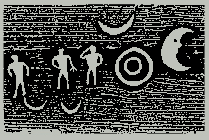|
Astronomy Formulas -- Page One PERIODICITY FORMULAS -- DEFINITIONS -- NOTATION -- TIME FORMULAS |
| Page Two -- ILLUMINATION GEOMETRY -- MISC. FORMULAS -- PLANETARY DATA |
| PERIODICITY FORMULAS: | |
| Sidereal Orbit | (365.25636042 + 1.1 x 10-7 TE) days |
| Tropical Year | (365.24219878 - 6.14 x 10-6 TE) days |
| Eclipse Year | (346.620031 + 3.2 x 10-5 TE) days |
|
|
|
| Sidereal Lunar Orbit | (27.3216610 - 2.0 x 10-7 T) days |
| Lunar Mean Daily Sidereal Motion | (13.1763582975 - 1.0224 x 10-8 T)° |
| Lunar Synodical Period | (29.5305992 - 2.0 x 10-7 T) days |
| Centenial General Precession Longitude | (1.396291666... + 0.0006180555...T)° |
|
Given T = Tropical centuries from 1900.0 N |
|
|
to calculate and view updated formulas. You just enter the date. Since 1997, when this page was published, many astronomy formulas have been refined. |
|
|
PERIODICITY FORMULAS -- NOTATION -- TIME FORMULAS -- PAGE TWO |
|
| Sidereal Orbit | is a revolution relative to a fixed celestial position. |
| Sidereal Noon | is the instant of transit of mean equinox relative to a fixed meridian position. |
| Fundamental Epoch of Sidereal Time |
(FE) is the instant 12 hours, 0 days, 1900 years A.D. with hours in mean sidereal time. |
| Ephemeris Time | is the actual count of solar days from a fixed meridian. |
| Tropical Year (YT) | is the period from equinox to equinox. |
| Eclipse Year (YE) | is the period between the earth and lunar orbit planes node crossings. |
| Temporal Unit (TU) | is 36,525 mean solar days since Jan. 0.5, 1900, UT. |
| Greenwich Mean Sidereal Time (GT) |
= 0.0 hours UT = 12 hours + aFMS |
| Universal Time (UT) | has replaced Mean Solar Time due to a recognition of the non-uniform rotation rate of the earth. |
| Lunar Synodic Period (S9) | is the period of time from one full or new moon to another, that is the time between consecutive alignments of the sun, earth and moon on a plane perpendicular to the plane of solar revolution. |
| Julian Date (JD) | The Julian Date is the Julian day number for the preceding noon plus the fraction of the day since that instant. A Julian Date begins at 12h 0m 0s and is composed of 86400 seconds. It is recommended that JD be specified as SI seconds in Terrestrial Time (TT) where the length of day is 86,400 SI seconds. |
| Julian Day Number (JDN) |
The Julian day number is the solar day number assigned in a continuous count of days beginning with zero assigned to Greenwich mean noon on 1 January 4713 BC, Julian proleptic calendar -4712. |
| Precession (PR) | is the retrograde rotation of the earth's axis relative to fixed celestial reference. |
| Annual Parallax | is the viewpoint difference due to the change in the earth's position relative to the sun. For the nearest star the angle is about 0.000222.° |
| Annual Aberration | is the angular shift in apparent position resulting from motion velocity of viewing from orbiting (moving) earth. |
| Diurnal Parallax | is the viewpoint difference due to the rotation of the earth. The amount varies with the latitude of the observer. |
| Diurnal Aberration | is the result of observing from a spining observing position on the surface of the earth. Velocity of the observer causes apparent shift to a maximum correction of about 0.0008333° at the equator. |
| Atmospheric Refraction | is the bending of light rays by the earth's atmosphere. |
|
PERIODICITY FORMULAS -- DEFINITIONS -- TIME FORMULAS -- PAGE TWO NOTATION: |
|
|
|
|
| DMS | Day, Mean Sidereal |
| d, h, m, s, | day, hour, minute, second |
| ES | Ephemeris Second |
|
|
|
|
|
|
|
|
|
|
|
|
|
|
|
|
|
|
|
|
|
|
|
|
| TE | Temporal Epoch |
|
|
|
| UT | Universal Time |
|
PERIODICITY FORMULAS -- DEFINITIONS -- NOTATION -- PAGE TWO |
|
|
|
|
|
|
|
|
|
|
|
|
|
|
|
|
|
|
|
|
|
|
|
|
|
|
|
|
|
|
|
|
|
|
|
: Mean Sidereal Time |
|
|
: Mean Sidereal Time |
|
|
|
|
|
|
|
|
|
|
|
|
|
|
Did ancient astronomers survey the Earth? - - Read the Archaeogeodesy Pages ©1997 by James Q. Jacobs. All
rights reserved. Download the Epoch
Calc v2012 Excel spreadsheet |
 |
